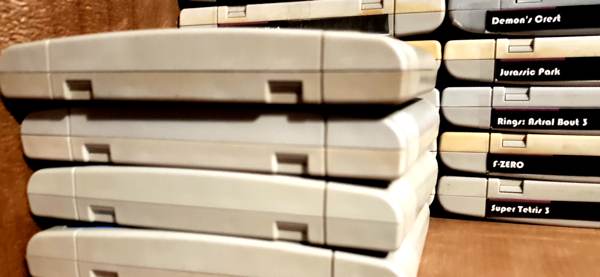Keeping any number of retro games sorted sure isn’t an easy task. But it doesn’t have to be super-difficult.
Over the weekend, I was struck (as I often am) by the desire to play a SNES game. Nothing unusual there; Nintendo’s 16-bit powerhouse is my all-time favourite retro gaming console, which means I’ve got a substantial library to pick from.
That’s a problem in itself, however, or at least it is if you have a PAL SNES or Japanese Super Famicom. I hate the US SNES with a passion, because it’s so incredibly ugly…
But the one thing I will (begrudgingly) admit is that at least Nintendo of America got spine sleeves right.
Line up a rack of US SNES games, and you can pick them straight away, because they’ve all gone spine labels.
The actual proper SNES/SFC carts are better, because they go into a much better looking system, but on the spines, you’ll find…
Which is a big problem when you’re looking at the spines of 100+ carts with the desire to play just one of them.
One solution to the problem would be proper boxes, but that poses its own issues. You can buy replacement custom-printed SNES boxes, but at a serious cost, and not for every single game out there.
Predictably, it’s the more popular fare that it’s easier to get boxes for, and that’s presuming I had the funds to spare.
In many cases, games I’d be boxing up (albeit in fake reproduction boxes) would be worth far less than I’d have to spend on the box to go around them, which feels ridiculous to me.
Again, I’m someone who plays the games, not places them on pedestals, never to played again. That’s always felt wasteful to me.
So I dug around, until I found this video, specifically aimed at folks like me:
A decent enough solution, although you do need label paper to print on.
One tip here is that the template used has an unusual-to-some format, because it’s an .xcf file. Photoshop won’t open that, and neither will Word. Instead, it’s for the GNU Image Manipulation Program, or GIMP for short. Yes, open source folks have unusual senses of humour. You can download GIMP for free here.
I wanted to experiment with sizing and placement, especially as I had a number of Japanese games with very long titles.
So I went for the low-cost, low fuss alternative. Namely, printing on paper and using tape to stick labels down.
Yes, it’s not quite as pretty as a permanent label, but it’s also not, y’know… permanent.
If I decide that I want a different style, or I want to throw graphics on there, I could do so. If I get it wrong with a piece of paper, it’s a minimal cost and waste compared to a label, and it’s going to be very easy to remove if I decide to go down a different path in the future.
One tip if you do follow the template used in that video; do at least one test run on paper even if you do plan to use full labels anyway, just for sizing purposes. You can thank me later.
Also, apropos of retrogaming, I got quoted by the ABC about the history of the Commodore 64, which you can read over here.
Just reading it has made me all kinds of nostalgic for the Amiga 500… which sort of works, as long as you don’t think about it too deeply.
